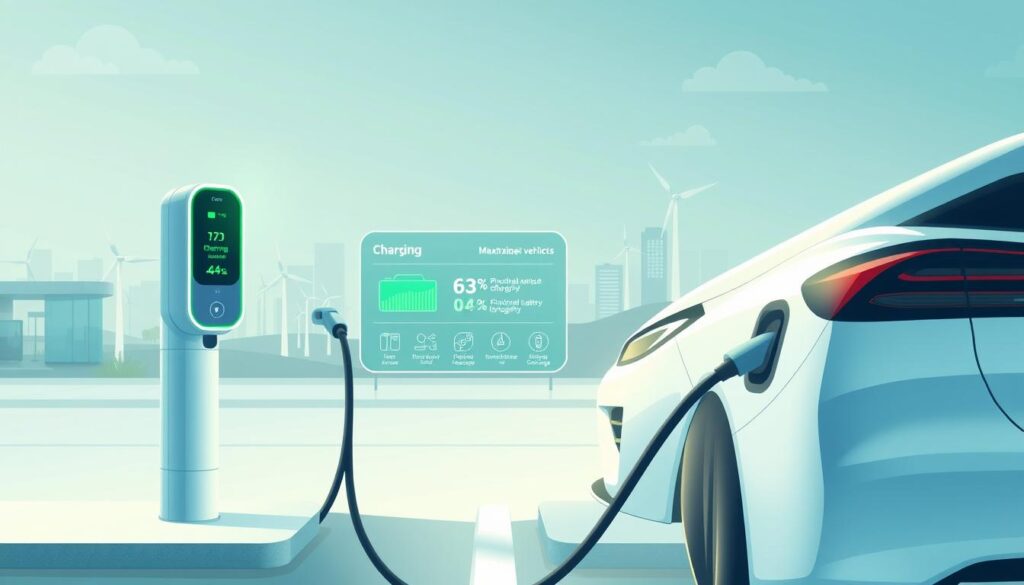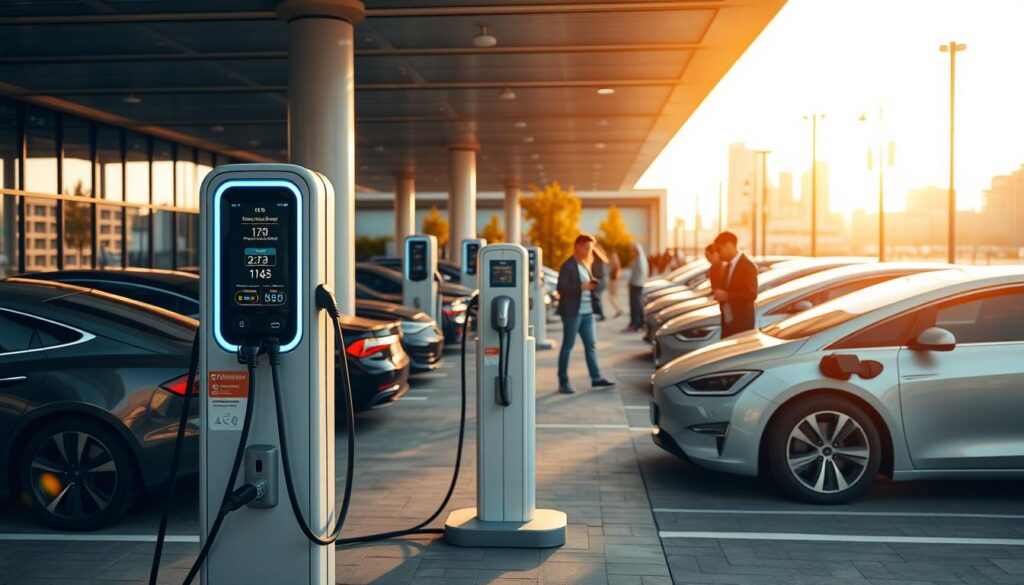How to Charge Your Electric Car Efficiently
Did you know that over 64 percent of electric vehicle owners primarily plug in at their own residence? This simple fact highlights a major shift from the traditional gas station routine.
Owning an EV unlocks a new level of convenience. You are no longer tied to dedicated fuel stops. The power to charge your vehicle exists at home, work, shopping centers, and along highways.
True efficiency, however, goes beyond just finding a plug. It’s about smart strategy. Understanding the best times and places to charge based on your daily life protects your battery and saves you money.
This guide is your roadmap. We will demystify the entire process. You’ll learn about different charging levels, home setup, and using public networks with confidence.
Whether you’re considering your first electric vehicle or are a current owner, the insights here will help you maximize your EV experience.
Key Takeaways
- Home charging is the most common and convenient method for most EV drivers.
- Electric vehicles offer flexible charging options unavailable to gas-powered cars.
- Efficient charging involves strategic timing and location choices.
- Proper charging knowledge can extend your vehicle’s battery life.
- This guide covers everything from basic home installation to advanced trip planning.
Introduction to Efficient EV Charging
The biggest advantage of EV ownership is the ability to fuel up where you park. This eliminates the regular gas station trips familiar to drivers of traditional vehicles. For daily needs, the most convenient and cost-effective charging happens overnight at home.
A key mindset shift involves moving from reactive fueling to proactive charging. Instead of waiting for a low battery, you top up your vehicle opportunistically. This approach saves time and supports long-term battery health.
True charging efficiency balances several factors. These include energy cost, charging speed, and the convenience of the charging station location. Matching the right method to your situation is crucial.
While public charging networks are vital for travel, home-based power delivers the best value for routine use. Understanding your driving habits and available options lets you create a personalized plan. This strategy maximizes convenience and minimizes cost for all EV owners.
Understanding Charging Levels and Station Types
The EV charging landscape is built around three primary power delivery methods. Each level serves different needs based on time availability and charging requirements.
Level 1, 2, and 3 Explained
Level 1 charging uses standard 120-volt household outlets. This method provides about 4-5 miles of range per hour. It’s perfect for overnight top-ups if you drive minimal daily miles.
Level 2 charging represents the sweet spot for most owners. Using 240-volt circuits, it delivers 12-40 miles of range per hour. This type of station works well for home installation and workplace charging.
Level 3 DC fast charging operates differently. It bypasses your car’s converter to deliver DC power directly. This allows for much faster charging speeds on road trips.
DC Fast Charging Benefits
The main advantage of fast charging is reduced stop times. You can add 150-200 miles of range in just 20-30 minutes. This makes long-distance travel practical in electric vehicles.
Most automakers recommend limiting frequent use of these high-power chargers. Charging to around 80% helps preserve long-term battery health. New ultra-fast charging stations reaching 350-400 kW are now being deployed.
Understanding these different charging levels helps you choose the right option for each situation. Matching the charger type to your needs ensures optimal efficiency.
How to Charge Your Electric Car Efficiently

The most effective approach to EV charging involves understanding when and how much to charge rather than just where to plug in. Smart habits protect your investment and save money over time.
Insider Tips for Optimal Charging
Follow the golden 80% rule for daily charging. This practice significantly extends battery lifespan. Reserve full charges for trips requiring maximum range.
Lithium-ion batteries experience more stress during the final 20% of charging. Fast charging also slows dramatically beyond 80%, making waiting inefficient.
Establish a routine of plugging in whenever parked. Embrace “opportunity charging” instead of waiting for low battery levels. This approach keeps your vehicle ready.
Take advantage of off-peak electricity rates by scheduling overnight charging. This simple adjustment can save hundreds of dollars annually on your power bill.
| Charging Scenario | Recommended Limit | Primary Benefit | Ideal Usage |
|---|---|---|---|
| Daily Home Charging | 80% | Battery Longevity | Overnight sessions |
| Long Distance Travel | 100% | Maximum Range | Trip preparation |
| Public Fast Charging | 80% | Time Efficiency | Road trips only |
| Workplace Charging | 90% | Convenience | Opportunity top-ups |
Precondition your battery before fast charging sessions, especially in cold weather. This prepares the battery to accept higher charging rates.
Remember that slower charging is better for battery health. Choose Level 2 charging when time permits to reduce heat stress. Monitor your patterns through your vehicle’s app for optimization opportunities.
Keep your battery between 20-80% for daily driving. This middle range minimizes degradation while maintaining sufficient range for most needs.
Home Charging: Best Practices and Setup Tips

Your home charging setup serves as the foundation for your entire electric vehicle experience. Getting this right ensures convenience and protects your investment.
Professional installation makes all the difference. A licensed electrician assesses your electrical panel’s capacity for safe operation.
Installation and Safety Considerations
Always hire a qualified professional for your charger installation. They install a dedicated circuit with proper breakers to handle the electrical load.
Never use extension cords for vehicle charging. These cannot handle the required power and create serious fire hazards.
Consider future needs during installation. A higher-capacity circuit accommodates faster charging or additional vehicles later.
Optimizing Charging Time and Cost
Program your home charging sessions for off-peak hours. This simple adjustment can cut your electricity costs significantly.
Set your charge limit to 80% for daily use. This practice extends your battery life while maintaining sufficient range.
Explore utility company programs offering rebates or special rates. Many provide incentives for efficient charging station usage.
Public Charging Networks: Navigating and Using Rapid Chargers

Public charging stations have transformed from rare finds to common amenities across the country. Knowing the major networks and proper etiquette makes using them straightforward.
Popular Networks and Their Features
The Tesla Supercharger network leads in reliability with over 40,000 chargers. It recently opened to non-Tesla vehicles via adapters.
Electrify America grows rapidly with 350 kW ultra-fast chargers. These stations are perfect for highway travel.
EVgo focuses on urban areas with Plug & Charge technology. This feature simplifies the process in compatible vehicles.
ChargePoint operates the largest Level 2 network. You’ll find these spots at shopping centers and workplaces.
Download network apps like Tesla and Electrify America before trips. Create accounts in advance to avoid delays when you need power.
Essential Charging Etiquette
Move your vehicle promptly after charging completes. This avoids idle fees and helps other drivers.
Stop at 80% on fast chargers unless you need maximum range. Charging slows significantly beyond this point.
Never unplug another person’s vehicle. Only park in designated spots when actively charging.
Use aggregator apps like PlugShare to check real-time availability. These tools show user reviews and connector types across all networks.
Fast Charging vs Level Charging: Evaluating Your Options
The decision between rapid DC charging and standard level charging hinges on your driving needs and battery health priorities. Each method serves distinct purposes in your electric vehicle experience.
Comparing Charging Speeds and Battery Impact
Level 2 charging delivers 25-75 miles of range per hour using 7-22 kW power. This gentle approach works well for daily commuting and workplace charging. It causes minimal stress to your battery chemistry.
DC fast charging operates at 50-350 kW, adding 100-200+ miles in just 30 minutes. The high power generates significant heat during this rapid charging process. Frequent use can accelerate battery degradation over time.
Cost differences are substantial between these charging methods. Level 2 public charging typically costs $1-3 per hour or $0.20-0.30 per kWh. Fast charging runs $0.40-0.60 per kWh, making regular use expensive.
| Feature | Fast Charging | Level 2 Charging | Best Use Case |
|---|---|---|---|
| Charging Speed | 100-200+ miles in 30 min | 25-75 miles per hour | Time-sensitive situations |
| Battery Impact | Higher stress and heat | Gentle on battery | Daily maintenance charging |
| Cost per Session | $0.40-0.60 per kWh | $0.20-0.30 per kWh | Budget-conscious charging |
| Ideal Frequency | Road trips and emergencies | Daily and routine use | Long-term battery health |
Reserve fast charging for long journeys and emergency situations. Use level chargers for daily commuting to maximize your battery’s lifespan. Modern vehicles have protection systems, but consistent slower charging preserves capacity.
Charging Connectors and Compatibility: What You Need to Know
Navigating the world of EV charging connectors can seem confusing at first glance. Different plug types serve various charging levels and vehicle brands. Understanding these differences ensures you can power up anywhere.
Understanding Standard Connector Types
The J1772 connector is the North American standard for Level 1 and 2 charging. Virtually all non-Tesla vehicles use this plug type for AC charging. Most public station locations support this connector.
For DC fast charging, the Combined Charging System (CCS) adds pins to the J1772 design. This allows one port to handle both AC and DC power. Most American and European evs feature CCS compatibility.
CHAdeMO represents another fast charging standard, primarily found on older Japanese vehicles. While still available, its prevalence is declining as CCS becomes dominant.
The emerging North American Charging Standard (NACS) is gaining rapid adoption. Formerly the Tesla connector, major automakers are adopting this universal plug. Starting in 2024-2025, many new vehicles will feature built-in NACS ports.
Tesla owners can use included adapters for J1772 chargers. Non-Tesla drivers will soon access Superchargers with adapters or native NACS support. Always check your vehicle’s specifications and carry relevant adapters for maximum flexibility.
Payment Methods and Charging Etiquette in Public Stations
Modern public charging stations offer several payment approaches to suit different user preferences. Knowing your options makes every charging session smooth and stress-free.
How to Authenticate and Pay
Smartphone apps provide the most comprehensive experience. Networks like Electrify America and ChargePoint offer dedicated applications. These tools let you locate stations, start sessions, and monitor progress.
RFID cards and key fobs deliver tap-and-go convenience. Many networks provide physical cards for easy authentication. This method works well when phone connectivity is limited.
Contactless credit card payment requires no accounts or apps. Simply tap your card to begin the charging session. This option offers maximum flexibility for occasional users.
Each payment method has distinct advantages. App users often receive discounted rates for their charging sessions. Physical cards provide reliable access without smartphone dependency.
Proper etiquette ensures positive experiences for all users. Move your vehicle promptly after charging completes. This avoids idle fees that many networks charge.
Limit fast charging to 80% at busy stations. This practice allows others to access the charger quickly. Always report malfunctioning equipment through network apps.
Following these simple guidelines creates a better environment. Courteous behavior makes public charging enjoyable for everyone involved.
Preparing for Road Trips: Charging on the Go
Long-distance travel in an EV is now more practical than ever, thanks to extensive charging stations and smart planning tools. A little preparation eliminates range anxiety and turns your journey into a smooth adventure.
Modern apps and vehicle systems handle the complex calculations for you. They find the best fast chargers along your route based on your vehicle’s specific needs.
Route Planning and Charger Locator Apps
Specialized apps like A Better Route Planner are essential. They calculate optimal stops using your current battery level, driving speed, and weather.
Always check recent reviews on PlugShare before you depart. This helps you avoid stations with reported outages or congestion.
Your car’s built-in navigation is also a powerful tool. Many EVs can precondition the battery automatically before you arrive at a charger.
Preconditioning and Battery Management
Preconditioning warms your battery for optimal charging, especially in cold weather. This can cut charging time significantly.
Plan to arrive at charging stations with about 10-15% range remaining. This provides a safety buffer.
Carry multiple payment options: a credit card, RFID card, and necessary network apps. This ensures you can plug in anywhere.
| Planning Tool | Primary Function | Key Benefit |
|---|---|---|
| A Better Route Planner (ABRP) | Dynamic route calculation | Customized stops for your specific EV model |
| PlugShare | Station reviews & status | Identifies reliable charging locations |
| Vehicle Navigation | Integrated trip planning | Automatic battery preconditioning |
Conclusion
Electric vehicle ownership represents a fundamental shift from reactive fueling to intelligent energy management. Efficient charging combines technical knowledge with your unique driving patterns.
Unlike gas vehicles requiring dedicated stops, EVs enable proactive charging integrated into daily life. Most power-ups happen at home, making a Level 2 station your best investment.
Preserving your vehicle’s battery through smart practices ensures long-term performance. Public networks continue improving with faster chargers and better amenities.
Download essential apps and practice locally before road trips. The convenience and savings quickly feel natural. Most owners happily leave gas stations behind forever.
FAQ
What’s the difference between Level 1, Level 2, and DC fast charging?
How long does it take to fully charge an electric vehicle at home?
Are all electric cars compatible with every public charging station?
How do I pay for a session at a public charging station?
Is frequent fast charging bad for my EV’s battery?
What is the best way to find charging stations on a road trip?

Eduard Kingly is a travel and lifestyle content creator with a focus on personal development and education. He combines firsthand travel experiences with research-driven insights to guide readers in discovering new places, building better habits, and pursuing meaningful learning.




